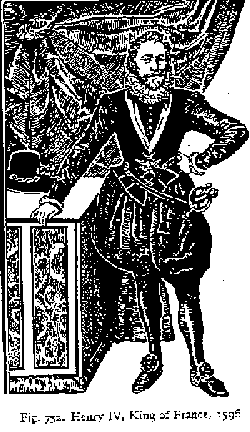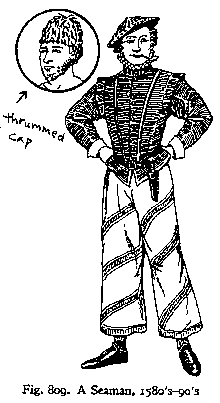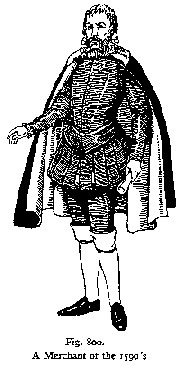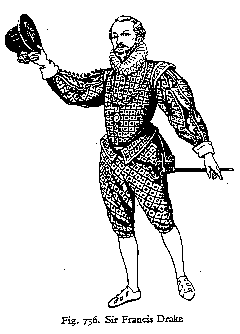Men's Clothing
 A manís suit consisted
of a doublet, jerkin, and hose. He was not truly dressed without a cloak
and hat, either. Underneath it, he wore a long shirt and sometimes drawers.
There was a wide variety of styles. The heavily padded, peascod doublet
reached its peak of excess in the 80s, and doublets have started to become
somewhat more natural looking in the later 90s. They still have a pointy
waist and a skirt of tabs most of the time, but there were other styles.
Level waists were sometimes worn throughout the period by practical people,
and especially the lower classes. A doublet with a natural waist, comfortable
sleeves, and deep skirt (to mid-thigh, like the "Beefeaters") would be
appropriate working-class wear. Doublets with a very narrow (almost vestigial)
skirt were also worn, especially with Venetians. Sleeves were usually fitted,
with buttons up the back of the arm near the cuff. There was usually a
wing or roll at the shoulder junction of the sleeve and body. Big, puffy
leg-o-mutton-like sleeves were also worn, often with the narrow-skirted-Venetion
breeches look. The jerkin was sleeveless and cut to fit over the doublet.
It was often left open. Collars were very high in the 70s (up around oneís
ears), but have been becoming more reasonable since then.
A manís suit consisted
of a doublet, jerkin, and hose. He was not truly dressed without a cloak
and hat, either. Underneath it, he wore a long shirt and sometimes drawers.
There was a wide variety of styles. The heavily padded, peascod doublet
reached its peak of excess in the 80s, and doublets have started to become
somewhat more natural looking in the later 90s. They still have a pointy
waist and a skirt of tabs most of the time, but there were other styles.
Level waists were sometimes worn throughout the period by practical people,
and especially the lower classes. A doublet with a natural waist, comfortable
sleeves, and deep skirt (to mid-thigh, like the "Beefeaters") would be
appropriate working-class wear. Doublets with a very narrow (almost vestigial)
skirt were also worn, especially with Venetians. Sleeves were usually fitted,
with buttons up the back of the arm near the cuff. There was usually a
wing or roll at the shoulder junction of the sleeve and body. Big, puffy
leg-o-mutton-like sleeves were also worn, often with the narrow-skirted-Venetion
breeches look. The jerkin was sleeveless and cut to fit over the doublet.
It was often left open. Collars were very high in the 70s (up around oneís
ears), but have been becoming more reasonable since then.
Hose were quite varied in style, and there were two parts: the upper
hose and the nether hose (which look like stockings or tights to us). The
basic upper hose styles were knee-breeches (Venetians or gallygaskins),
paned trunk hose, and short trunk hose (paned or plain) with canions.
Knee-breeches came in several styles: very full throughout, very tight
throughout, and very gathered and the top and narrow at the knee (like
an inverted pear or turkey-leg). They might button or hook at the knee
(either on the outside or inside of the knee), or might even be left open.
They would be worn with over-the-knee length stockings, either tucked inside
or pulled over the breeches, that were held up by garters. The garters
might be quite ostentatious, or they might be simple bands with a buckle,
with the stocking tops rolled down over to hide them (like 1920s flappers).
Sailors and laborers often wore breeches that were very loose all the way
down and left open at the bottom, falling to about mid-calf. Codpieces
were not worn with any of these styles.
 Paned trunk hose
(puffy shorts made of strips of material laid over a lining cloth that
showed through the panes) were worn for a good part of the century. At
this time, the fashionable line has them coming to mid-thigh and padded
to a bell-like shape (as opposed to the onion or pumpkin shape popular
previously). They were worn with nether-hose (long stockings, like tights).
Codpieces may still be found with them, but they are going out of style.
Paned trunk hose
(puffy shorts made of strips of material laid over a lining cloth that
showed through the panes) were worn for a good part of the century. At
this time, the fashionable line has them coming to mid-thigh and padded
to a bell-like shape (as opposed to the onion or pumpkin shape popular
previously). They were worn with nether-hose (long stockings, like tights).
Codpieces may still be found with them, but they are going out of style.
Very, very short trunk hose (sometimes little more than a padded roll
around the hips) might be attached worn with canions -- fitted bicycle-shorts-like
extensions that came to around the knee. Like knee-breeches, they would
be worn with stockings, which may be pulled up under or over the canions
and gartered. The trunks may be paned or unpaned (e.g. just cloth).
Both ruffs and falling bands (what people commonly think of as "musketeer"
or "puritan" style collars) were being worn, sometimes both together. At
the wrist might be ruffs or cuffs, with cuffs becoming more popular. Lace
is started to be used more with collars and cuffs.
The basic shirt underneath this all was a simple one -- a front and
back gathered to a neck band, possibly with a gusset on the side of the
neck, and square-cut sleeves gathered into a wrist band with a gusset under
the arm Fancy collars and cuffs were often separate, or might button
onto the bands. There also might be a simple fold-over collar.
A gentleman would wear a cloak and a hat. There were a number of cloak
styles: short Dutch cloaks, Spanish cloaks (short, with a large decorative
hood that hung down the back), and French cloaks (à la reitre, very
long and often with a shoulder-length mantle over it). Cloaks were commonly
worn over one shoulder (leaving the sword arm free). Cloak ties and clasps
are rarely seen, and draping the cloak rakishly and keeping it from falling
off must have been an important social skill. Cloaks sometimes had hanging
sleeves attached, which makes it hard to tell the different between them
and a coat or cassock. The cassock was a loose-fitting (no waist), hip-length
garment with sleeves, sometimes open sides, that was usually put on over
the head (did not button all the way down). A loose coat of this kind was
popular with sailors.
 The flat, beret-like
cap that was worn most of this century is going out of style, and the tall-crowned,
flat-top hat (the forerunner of the "pilgrim" hat) is now the height of
fashion. It is often worn with a feather or decorative hatband.
The flat, beret-like
cap that was worn most of this century is going out of style, and the tall-crowned,
flat-top hat (the forerunner of the "pilgrim" hat) is now the height of
fashion. It is often worn with a feather or decorative hatband.
Boots were worn for riding, but shoes were considered appropriate for
indoors. Heels are just coming into fashion. The trendy shoe is cut with
a tongue and has side-lachets fastened over the instep with a bow. Slashed
slipper-like shoes are going out of fashion.
Men wore beards almost universally, cut in different styles -- the "van
dyke"-like style, spade, square, "pique-devant", etc. Moustaches were not
worn alone. Hair has been quite close cropped for the last few decades,
but is starting to get longer.
Remember that a working man has looked a lot the same for a hundred
years. Peasants could still be found wearing "joined hose" (i.e. tights)
with a codpiece, or straight, loose trousers falling to mid-calf, with
a loose coat over their shirt hanging to mid-thigh, and belted with a bit
of cord. The effect is very medieval-looking.
Descriptions of Pictures
From the top:
1.) Henry IV of France, 1596, in
a fairly simple outfit of black silk and velvet. He is wearing "culottes
Bearnais," a fairly loose, comfortable style of unpaned trunk hose that
come just above the knee. Since Charlemagne's time, the Gascons have been
known for their baggy pants. This picture is from Norris, not generally
a reliable source, but was used in the original handout from which these
materials were developed because they were black-and-white, highly compressable
images from a non-copyright source. They should always be questioned and
other contemporary documentary sources should be used to validate the details
of any costume. They are used here merely to give an idea of the general
silhouette.
2.) a sailor of the 80s-90s. He
is wearing a fairly standard doublet with the loose trousers worn by sailors
and many other working men. His cap appears to be a knit one. The
detail next to him illustrates a "thrummed cap," a style where little tufts
are pulled through a felt background, rather like a hooked rug. Norris.
3.) another sailor of the same time,
with his navigational tools. He is wearing gallygaskins (wide, knee-length
trunk hose which are generally quite comfortable). On top he wears a cassock:
a kind of loose, comfortable jacket that was popular with many middle class
men. Norris.
4.) an English merchant. He is wearing
paned upper trunk hose with long canions. His nether hose (stockings) are
pulled up over the canions and gartered below the knee. Pictures of working
men often show them with their stockings falling down. Norris.
5.) Sir Francis Drake. He is wearing
Venetians. His sleeves are open to reveal an undersleeve -- the opening
is trimmed with buttons and loops, which are probably more for decoration
than anything else. Norris.
6.) A farm hand. Over his shirt
he wears a short-sleeved, loose garment that looks a lot like an old-fashioned
tunic. (See the
Egg Dance for more stylish examples). He wears the high-crowned hat
popular in this time, one that we associate strongly with the Puritans
of New England. Norris.
 Home
to Poulet Gauche
Home
to Poulet Gauche Back
to Clothing
Back
to Clothing Bibliography
Bibliography
-c.
t. iannuzzo
 Paned trunk hose
(puffy shorts made of strips of material laid over a lining cloth that
showed through the panes) were worn for a good part of the century. At
this time, the fashionable line has them coming to mid-thigh and padded
to a bell-like shape (as opposed to the onion or pumpkin shape popular
previously). They were worn with nether-hose (long stockings, like tights).
Codpieces may still be found with them, but they are going out of style.
Paned trunk hose
(puffy shorts made of strips of material laid over a lining cloth that
showed through the panes) were worn for a good part of the century. At
this time, the fashionable line has them coming to mid-thigh and padded
to a bell-like shape (as opposed to the onion or pumpkin shape popular
previously). They were worn with nether-hose (long stockings, like tights).
Codpieces may still be found with them, but they are going out of style.
 A manís suit consisted
of a doublet, jerkin, and hose. He was not truly dressed without a cloak
and hat, either. Underneath it, he wore a long shirt and sometimes drawers.
There was a wide variety of styles. The heavily padded, peascod doublet
reached its peak of excess in the 80s, and doublets have started to become
somewhat more natural looking in the later 90s. They still have a pointy
waist and a skirt of tabs most of the time, but there were other styles.
Level waists were sometimes worn throughout the period by practical people,
and especially the lower classes. A doublet with a natural waist, comfortable
sleeves, and deep skirt (to mid-thigh, like the "Beefeaters") would be
appropriate working-class wear. Doublets with a very narrow (almost vestigial)
skirt were also worn, especially with Venetians. Sleeves were usually fitted,
with buttons up the back of the arm near the cuff. There was usually a
wing or roll at the shoulder junction of the sleeve and body. Big, puffy
leg-o-mutton-like sleeves were also worn, often with the narrow-skirted-Venetion
breeches look. The jerkin was sleeveless and cut to fit over the doublet.
It was often left open. Collars were very high in the 70s (up around oneís
ears), but have been becoming more reasonable since then.
A manís suit consisted
of a doublet, jerkin, and hose. He was not truly dressed without a cloak
and hat, either. Underneath it, he wore a long shirt and sometimes drawers.
There was a wide variety of styles. The heavily padded, peascod doublet
reached its peak of excess in the 80s, and doublets have started to become
somewhat more natural looking in the later 90s. They still have a pointy
waist and a skirt of tabs most of the time, but there were other styles.
Level waists were sometimes worn throughout the period by practical people,
and especially the lower classes. A doublet with a natural waist, comfortable
sleeves, and deep skirt (to mid-thigh, like the "Beefeaters") would be
appropriate working-class wear. Doublets with a very narrow (almost vestigial)
skirt were also worn, especially with Venetians. Sleeves were usually fitted,
with buttons up the back of the arm near the cuff. There was usually a
wing or roll at the shoulder junction of the sleeve and body. Big, puffy
leg-o-mutton-like sleeves were also worn, often with the narrow-skirted-Venetion
breeches look. The jerkin was sleeveless and cut to fit over the doublet.
It was often left open. Collars were very high in the 70s (up around oneís
ears), but have been becoming more reasonable since then.

 The flat, beret-like
cap that was worn most of this century is going out of style, and the tall-crowned,
flat-top hat (the forerunner of the "pilgrim" hat) is now the height of
fashion. It is often worn with a feather or decorative hatband.
The flat, beret-like
cap that was worn most of this century is going out of style, and the tall-crowned,
flat-top hat (the forerunner of the "pilgrim" hat) is now the height of
fashion. It is often worn with a feather or decorative hatband.